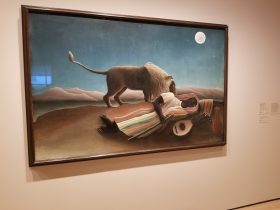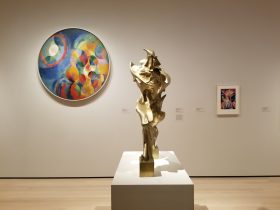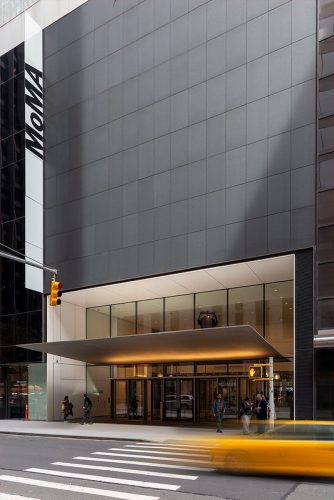The Museum of Modern Art (MoMA) is and has been a touchstone in museum and art culture, located in the heart of Manhattan. The MoMA was the first museum “in America to integrate twentieth-century fine and applied art” and “has built an unrivaled multidepartmental collection while at the same time conducting a coherent and adventurous program of exhibitions and related educational activities.”[1] Since the beginning, the Museum has and continues to cater to people of all ages, appearances, and orientations – as art, especially modern art, has no restrictions.
The MoMA, according to its director in 2004, Glenn D. Lowry, is “predicated on a relatively simple proposition, that the art of our time – modern art – is as vital and important as the art of the past.”[2] The Museum’s mission began with the vision its three founders, Lillie P. Bliss, Mary Quinn Sullivan, Abby Aldrich Rockefeller had when they met each other on a trip to Egypt in 1928.[3] Bliss was the daughter of a textile manufacturer as well as a collector of modern paintings and prints.[4] Sullivan worked as an art teacher in New York, and although was not a collector of art herself, her husband, Cornelius J. Sullivan, was.[5] Rockefeller, on the other hand, cared deeply for classic and modern art, and shared a “concern for the arts of her own time.”[6] The three banded together to not only continue collecting modern art, but aimed to put it on public display in their newly founded museum. The MoMA first opened its doors November 1st, 1929.[7] The Museum, however, struggled in a time when “few [people] attempted to collect modern art seriously.”[8] Modern art in the early 20th century was not taken as seriously as art made during the Renaissance, for example. Bliss, Sullivan, and Rockefeller were aware that constructing the MoMA would be a risky venture, but their growing board of trustees and appointment of Alfred H. Barr Jr. as their director in 1929 proved to garner success.[9]

The MoMA was officially established “in rented quarters on the twelfth floor of an office building at 730 Fifth Avenue…” and held its first exhibition seven days after opening.[10] On November 8th, 1929, paintings and prints from the combined collections of Bliss, Sullivan, and Rockefeller were featured in the exhibition Cézanne, Gauguin, Seurat, van Gogh, which attracted about forty-nine thousand New Yorkers and general visitors to the tight gallery rooms of the museum.[11] While their first and subsequent exhibits were garnered them great attention, the MoMA lacked a permanent collection until 1931, as all exhibits featured either pieces from the founders’ collections or from temporary donations from trustees.[12] Lille P. Bliss, before her passing in 1931, advised Barr and the board of trustees that she would donate her paintings and prints to the MoMA’s permanent collection, as well as give them her permission to sell some of her collection for the Museum’s improvement, if needed.[13] Her collection continued to be featured as an exhibition item according to The Bulletin of the Museum of Modern Art.[14] The other two founders would follow Bliss’s lead, both donating their collection to the Museum and allowing for their paintings to be sold to further fund the MoMA.[15]
The number of exhibitions the MoMA would feature would only continue to rise. According to the same, initial issue of The Bulletin of the Museum of Modern Art, the Museum would host seasonal exhibits, starting in the summer of 1933 until September of the same year.[16] However, exhibits at the MoMA would bend cultural standards more than simply displaying abstract art pieces alone. In 1934, chairman of the Department of Architecture, Philip Johnson, hosted a “controversial Machine Art show,” which entailed various machines, machine parts, and everyday machinery put on display on three of the Museum’s floors.[17] Many visitors were confused by the seemingly strange attention placed on what appeared to be ordinary machinery, but Johnson, as someone well versed in architecture, chose pieces that exemplified “new directions of modern design in the country.”[18] This strange deviance from what would be suspected as an exhibit in an art museum further cemented the MoMA’s break from expectations and established the Museum as a serious name in art culture.

Bliss, Sullivan, and Rockefeller wished not only to have modern art on display for the public, but to also continue studying the nuances of the modern masters, such as Van Gogh. So, the MoMA sought to pursue the scholarship of modern art. The Museum’s presence in the study of modern art began with their founding director, Alfred Barr, created a chart depicting the development and progression of modern art in the early 20th century. His chart led to the MoMA’s exhibition, Cubism and Abstract Art, in March 1936, and Barr’s work is still followed today.[19] Subsequent exhibitions in modern art would follow months after, such as Fantastic Art, Dada, Surrealism.[20] “Barr’s chart, with its dynamic red and black arrows, provided a kind of road map for thinking about the categories and influences of modern art that would prove influential for decades to come.”[21] In addition to the MoMA’s founding members contributing to modern art scholarship, the Museum also started its own Department of Publications in 1939, which would issue not only brochures and schedules for MoMA visitors and paying members, but would also publish various books on art study.[22] “A Museum of Modern Art publication came to mean the highest standard of book production” in 1939, especially for books on the subject of art study.[23]
The Museum has since grown to feature more than paintings, prints, and sculptures since its opening in 1929. In 1930, Lincoln Kirsten donated a photograph to the Museum – Walker Evans Lehmbruck’s Head of Man – which was the first photograph to come into the MoMA’s possession.[24] Then, in 1937, D. W. Griffith donated films made between 1913 and 1930 to the MoMA’s new, “permanent film archive.”[25] As of 2004, “The Museum owns over 6,000 drawings, 50,000 prints and illustrated books, 25,000 photographs, 3,200 paintings and sculptures, 24,000 works of architecture and design, and 20,000 films, videos, and other media works.”[26] Today, the MoMA continues to feature modern art of all mediums, whether it be prints, paintings, photographs, or machinery.

When the Museum moved to its current location on 11th Ave and West 53 Street in 1936, the building was remodeled to accommodate more gallery spaces and offices, as well as an auditorium below street-level for film viewings.[27] However, this upgrade did not mean the end of expansion for the MoMA. In 1971, Alanna Heiss founded MoMA PS1, which “opened its doors in 1976 with the show ‘Rooms,’” where 78 artists were invited to decorate their space with art.[28] Artists featured in the showrooms of MoMA PS1 were mostly New York artists, displaying examples of contemporary art pieces. In 2005, the MoMA disclosed their plan to “partner with one of its Queens collaborators, the P.S. 1 Contemporary Art Center, for an exhibition of New York artists.”[29] This move is in the same spirit as the Museum’s founders, Bliss, Sullivan, and Rockefeller, as they wished to study and celebrate the artists of the now.

Since its founding, the Museum of Modern Art has sought to be all-inclusive, diverse, and rich in culture. The MoMA was founded on the goal to educate New York and the country on the wonders of modern art, as well as celebrate the art and the artist while the artist was still alive. The MoMA has not only accomplished their goal through the founding of MoMA PS1, but has gone well beyond their dreams in setting a canon and standard for modern art. While people were skeptical of the seriousness of modern art in the early 20th century, Bliss, Sullivan, and Rockefeller were aware of its importance and have created, maintained, and expanded an “adventurous institurion [that] did nothing less than revolutionaize the very idea of the art museum in American life.”[30] The Museum has become the center for art students, New Yorkers, and tourists to study modernist masters in sophisticated peace despite the hustle and bustle of the city. Even in times of uncertainty, such as the unprecedented Covid-19 Pandemic, the MoMA still offers virtual exhibits and art-based activities for people stuck at home. The Museum continues to be an inclusive, diverse, and safe space for all who enter and care about art.
[1] Hunter, Sam. Museum of Modern Art, New York. (New York: Harry N. Abrams, Inc., 1984), 11.
[2] Lowry, Glenn D., “Introduction,” in MoMA Highlights: 350 Works from The Museum of Modern Art New York. (New York: The Museum of Modern Art, New York, 2004), 16.
[3] Hunter, Sam. Museum of Modern Art, New York. (New York: Harry N. Abrams, Inc., 1984), 9.
[4] Ibid., 9.
[5] Ibid., 9.
[6] Ibid., 10.
[7] Ibid., 9.
[8] Ibid., 9.
[9] Ibid., 11.
[10] The Museum of Modern Art. “Three Women Have a Vision,” MoMA, accessed February 12, 2020, https://www.moma.org/interactives/moma_through_time/1920/three-women-have-a-vision/
[11]Hunter, Sam. Museum of Modern Art, New York. (New York: Harry N. Abrams, Inc., 1984), 12.
[12] Ibid., 13.
[13] Ibid., 14.
[14] Goodyear, A. Conger. “Exhibition Schedule.” The Bulletin of the Museum of Modern Art 1, no. 1 (1933): 3. Accessed February 12, 2020. www.jstor.org/stable/4058011.
[15] Hunter, Sam. Museum of Modern Art, New York. (New York: Harry N. Abrams, Inc., 1984), 16.
[16] Goodyear, A. Conger. “Exhibition Schedule.” The Bulletin of the Museum of Modern Art 1, no. 1 (1933): 3. Accessed February 12, 2020. www.jstor.org/stable/4058011.
[17] Hunter, Sam. Museum of Modern Art, New York. (New York: Harry N. Abrams, Inc., 1984), 17.
[18] Ibid., 17.
[19] The Museum of Modern Art. “From a Sketch to a Canon,” MoMA, accessed February 12, 2020. https://www.moma.org/interactives/moma_through_time/1930/from-a-sketch-to-a-canon/
[20] Hunter, Sam. Museum of Modern Art, New York. (New York: Harry N. Abrams, Inc., 1984), 13.
[21] The Museum of Modern Art. “From a Sketch to a Canon,” MoMA, accessed February 12, 2020. https://www.moma.org/interactives/moma_through_time/1930/from-a-sketch-to-a-canon/
[22] Hunter, Sam. Museum of Modern Art, New York. (New York: Harry N. Abrams, Inc., 1984), 19.
[23] Ibid., 19.
[24] Ibid., 18.
[25] Ibid., 18.
[26] Bee, Harriet Schoenholz and Heliczer, Cassandra. MoMA Highlights: 350 Works from The Museum of Modern Art New York. (New York: The Museum of Modern Art, New York, 2004), 18.
[27] Hunter, Sam. Museum of Modern Art, New York. (New York: Harry N. Abrams, Inc., 1984), 19., 20.
[28] Rios, Daniela. “MoMA PS1 Early Adopters Look Back at Its 40-Year History.” artnet News, June 30, 2017. https://news.artnet.com/art-world/40-years-of-moma-ps1-521849.
[29] “A Museum Grew in Queens,” The New York Times, March 1, 2005, accessed February 13, 2020, https://www.nytimes.com/2005/03/01/opinion/a-museum-grew-in-queens.html.
[30] Hunter, Sam. Museum of Modern Art, New York. (New York: Harry N. Abrams, Inc., 1984), 19., 9.
Bibliography
“A Museum Grew in Queens,” The New York Times, March 1, 2005, accessed February 13, 2020, https://www.nytimes.com/2005/03/01/opinion/a-museum-grew-in-queens.html.
Bee, Harriet Schoenholz and Heliczer, Cassandra. MoMA Highlights: 350 Works from The Museum of Modern Art New York. New York: The Museum of Modern Art, New York, 2004.
Goodyear, A. Conger. “Exhibition Schedule.” The Bulletin of the Museum of Modern Art 1, no. 1 (1933): 3. Accessed February 12, 2020. www.jstor.org/stable/4058011.
Hunter, Sam. Museum of Modern Art, New York. New York: Harry N. Abrams, Inc., 1984.
The Museum of Modern Art. “Three Women Have a Vision,” MoMA, N/A, accessed February 12, 2020, https://www.moma.org/interactives/moma_through_time/1920/three-women-have-a-vision/
———— “From a Sketch to a Canon,” MoMA, N/A, accessed February 12, 2020. https://www.moma.org/interactives/moma_through_time/1930/from-a-sketch-to-a-canon/
Rios, Daniela. “MoMA PS1 Early Adopters Look Back at Its 40-Year History.” artnet News, June 30, 2017, accessed March 31, 2020, https://news.artnet.com/art-world/40-years-of-moma-ps1-521849.
